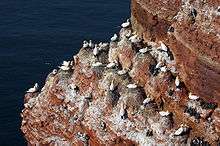Colony (biology)
In biology, a colony is composed of two or more conspecific individuals living in close association with, or connected to, one another, usually for mutual benefit such as stronger defense or the ability to attack bigger prey.[1] In contrast, a solitary organism is one in which all individuals live independently and have all of the functions needed to survive and reproduce.
Colonies, in the context of development, may be composed of two or more unitary (or solitary) organisms or be modular organisms. Unitary organisms have determinate development (set life stages) from zygote to adult form and individuals or groups of individuals (colonies) are visually distinct. Modular organisms have indeterminate growth forms (life stages not set) through repeated iteration of genetically identical modules (or individuals), and it can be difficult to distinguish between the colony as a whole and the modules within.[2] In the latter case, modules may have specific functions within the colony as a whole.
Some organisms are primarily independent and form facultative colonies in response to environmental conditions while others must live in a colony to survive (obligate). For example, some carpenter bees will form colonies when a dominance hierarchy is formed between two or more nest foundresses[3] (facultative colony), while corals are animals that are physically connected by living tissue (the coenosarc) that contains a shared gastrovascular cavity.
Colony types
Social colonies

Unicellular and multicellular unitary organisms may aggregate to form colonies. For example,
- Protists such as slime molds are many unicellular organisms that aggregate to form colonies when food resources are hard to come by, as together they are more sensitive to chemical cues released by preferred prey.
- Eusocial insects like ants and honey bees are multicellular animals that live in colonies with a highly organized social structure. Colonies of some social insects may be deemed superorganisms.
- Animals such as people and rodents form breeding or nesting colonies, potentially for more successful mating and to better protect offspring.
Modular organisms
Modular organisms are those in which a genet (or genetic individual formed from a sexually-produced zygote) asexually reproduces to form genetically identical clones called ramets.[4]
A clonal colony is when the ramets of a genet live in close proximity or are physically connected. Ramets may have all of the functions needed to survive on their own or be interdependent on other ramets. For example, some sea anemones go through the process of pedal laceration in which a genetically identical individual is asexually produced from tissue broken off from the anemone's pedal disc. In plants, clonal colonies are created through the propagation of genetically identical trees by stolons or rhizomes.
Colonial organisms are clonal colonies composed of many physically connected, interdependent individuals. Colonial organisms can be unicellular, as in the alga Volvox (a coenobium), or multicellular, as in the phylum Bryozoa. The former type may have been the first step toward multicellular organisms.[5] Individuals within a multicellular colonial organism may be called ramets, modules, or zooids. Structural and functional variation (polymorphism), when present, designates ramet responsibilities such as feeding, reproduction, and defense. To that end, being physically connected allows the colonial organism to distribute nutrients and energy obtained by feeding zooids throughout the colony.
Microbial colonies
A microbial colony is defined as a visible cluster of microorganisms growing on the surface of or within a solid medium, presumably cultured from a single cell.[6] Because the colony is clonal, with all organisms in it descending from a single ancestor (assuming no contamination), they are genetically identical, except for any mutations (which occur at low frequencies). Obtaining such genetically identical organisms (or pure strains) can be useful; this is done by spreading organisms on a culture plate and starting a new stock from a single resulting colony.
A biofilm is a colony of microorganisms often comprising several species, with properties and capabilities greater than the aggregate of capabilities of the individual organisms.
Life history
Individuals in social colonies and modular organisms receive benefit to such a lifestyle. For instance, it may be easier to seek out food, defend a nesting site, or increase competitive ability against other species. Modular organisms' ability to reproduce asexually in addition to sexually allows them unique benefits that social colonies do not have.[4]
The energy required for sexual reproduction varies based on the frequency and length of reproductive activity, number and size of offspring, and parental care.[7] While solitary individuals bear all of those energy costs, individuals in some social colonies share a portion of those costs.
Modular organisms save energy by using asexual reproduction during their life. Energy saved in this way allows them to put more energy towards colony growth, regenerating lost modules (due to predation or other cause of death), or response to environmental conditions.
See also
| Look up colony in Wiktionary, the free dictionary. |
- Ant colony
- Beehive (beekeeping)
- Bird colony
- Clonal colony
- Colonisation (biology)
- Coral reef
- Eusociality
- Superorganism
- Swarm
- Birth colony
- Austroplatypus incompertus
References
- ↑ Jackson, J.B.C. (1977). "Competition on Marine Hard Substrata: The Adaptive Significance of Solitary and Colonial Strategies". The American Naturalist. 111 (980): 743–767. doi:10.1086/283203.
- ↑ Begon, Michael; et al. (2014). Essentials of Ecology (4th ed.). Wiley. ISBN 0470909137.
- ↑ Dunn, T.; Richards, M.H. (2003). "When to bee social: interactions among environmental constraints, incentives, guarding, and relatedness in a facultatively social carpenter bee". Behavioral Ecology. 14 (3): 417–424. doi:10.1093/beheco/14.3.417.
- 1 2 Winston, J. (2010). "Life in the Colonies: Learning the Alien Ways of Colonial Organisms". Integrative and Comparative Biology. 50 (6): 919–933. doi:10.1093/icb/icq146.
- ↑ Alberts, Bruce; et al. (1994). Molecular Biology of the Cell (3rd ed.). New York: Garland Science. ISBN 0815316208. Retrieved 2014-06-11.
- ↑ Tortora, Gerard J.; Berdell R., Funke; Christine L., Case (2009). Microbiology, An Introduction. Berlin: Benjamin Cummings. pp. 170–171. ISBN 0-321-58420-1.
- ↑ Kunz, T.H.; Orrell, K.S. (2004). "Energy Costs of Reproduction". Encyclopedia of Energy. 5: 423–442.